This vegan Lotus Biscoff cake is the ultimate treat for Biscoff cookie fans. It’s easy to make and comes topped with Biscoff buttercream and a drizzle of the spread to turn it into a Biscoff drip cake.
Try it with a Biscoff latte.
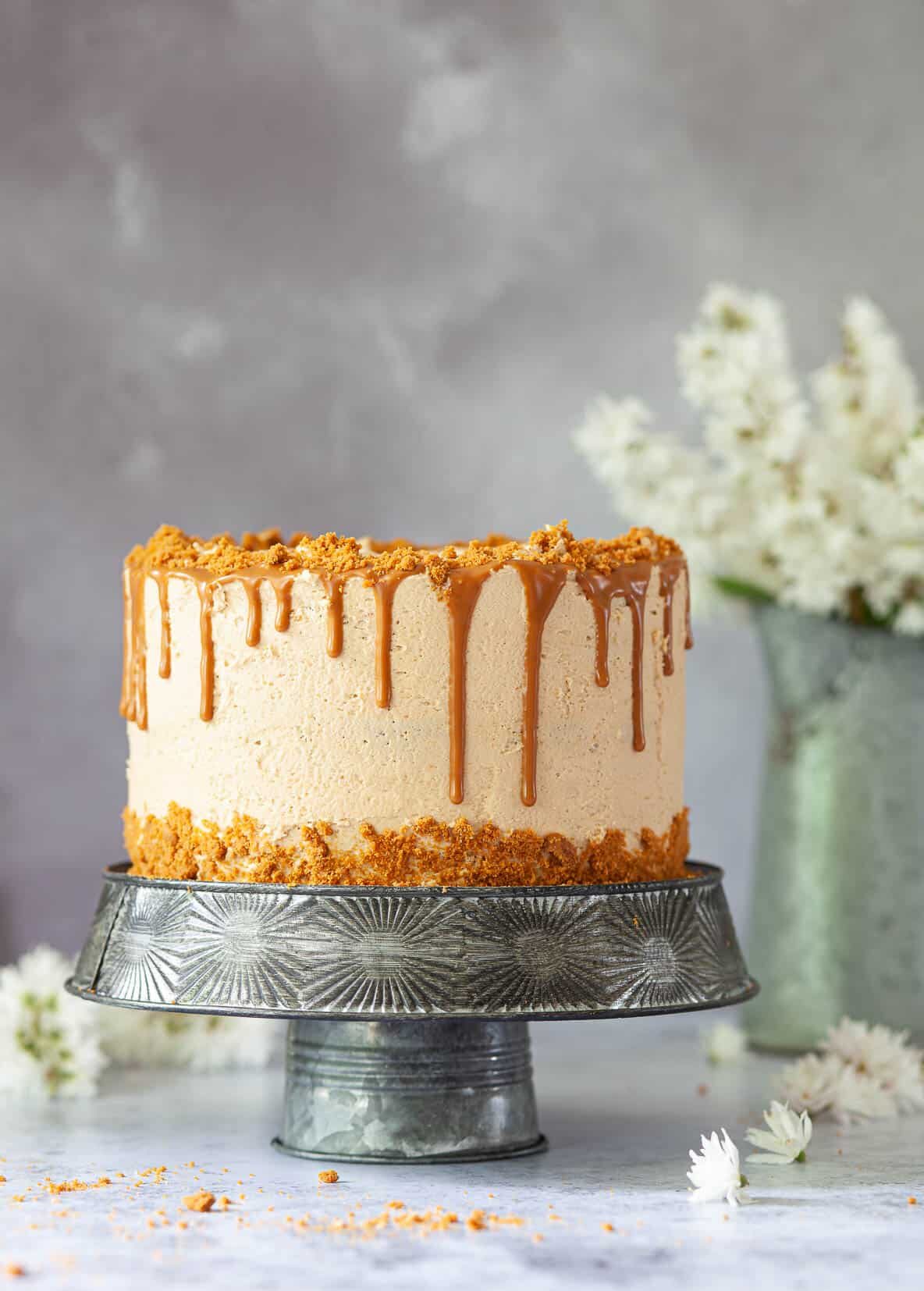
Want to Save This Recipe?
Jump to:
If somebody you care about has a soft spot for Biscoff cookies or spread, then I urge you to make this vegan Lotus Biscoff cake for them as soon as possible.
I know what you’re thinking: is Biscoff spread vegan? Yes, it really is. Lotus Biscoff cookies are also vegan. Double hurrah!
The Biscoff flavour runs right through all the elements of this cake. It’s in the sponge cake batter and in the buttercream as well as being immediately evident in the decorations. So I hardly need to point out that, flavourwise, this is the cake of contented dreams for many a Biscoff fan.
What I really love about this Lotus Biscoff cake are how the layers of sponge cake turn out. They are impressively soft – you would never know that no dairy or eggs were involved in the making.
Of course, with the drip effect and the crushed cookies, this cake wins in the looks department too. In fact, it would make a fantastic Biscoff birthday cake for anybody, not just those following a vegan diet.
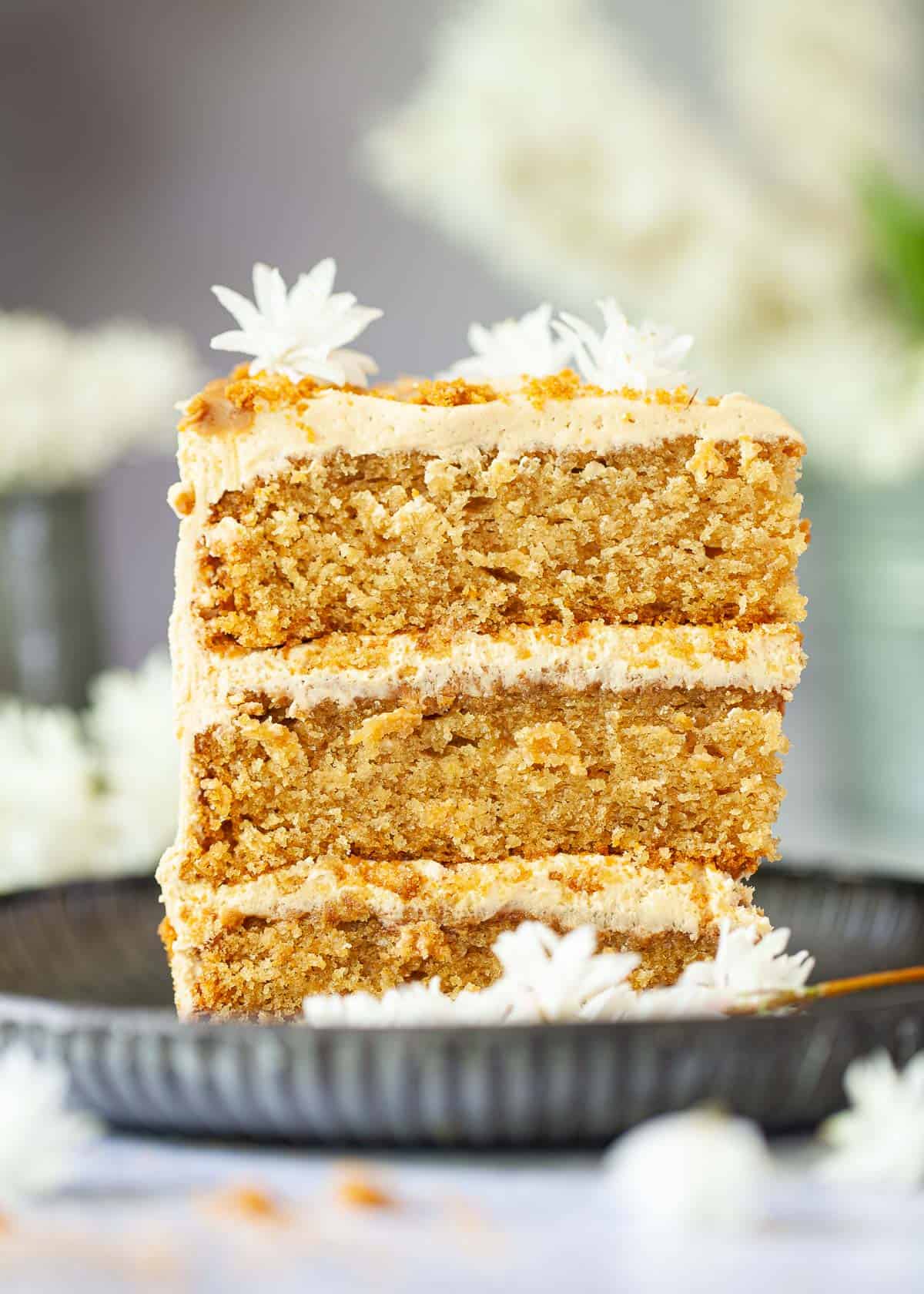
For a more elaborate Biscoff cake try my white chocolate and pear Biscoff cake. And for the simplest of bakes how about some Biscoff flapjack?
Why This Lotus Biscoff Cake is Special
If you need more reasons to persuade yourself to make this vegan Biscoff cake then consider this:
- It’s a quick and simple recipe to follow.
- And it’s deceptively easy to decorate.
- It’s loaded with Biscoff ingredients.
- The appearance of this Biscoff drip cake is eye-catching and it makes the flavour of this cake immediately obvious.
- It’s large enough to serve 8-10 people.
- This Lotus Biscoff caket keeps fresh for 3-4 days
- And it can also be frozen.
All in all, this is a fantastic recipe for any Biscoff fan. Make it for a special occasion, such as a birthday, when an easy, straightforward Lotus Biscoff cake recipe that produces a stunning cake is the order of the day. You’ll be amazed how each it is to make this Biscoff drip cake.
Ingredients notes
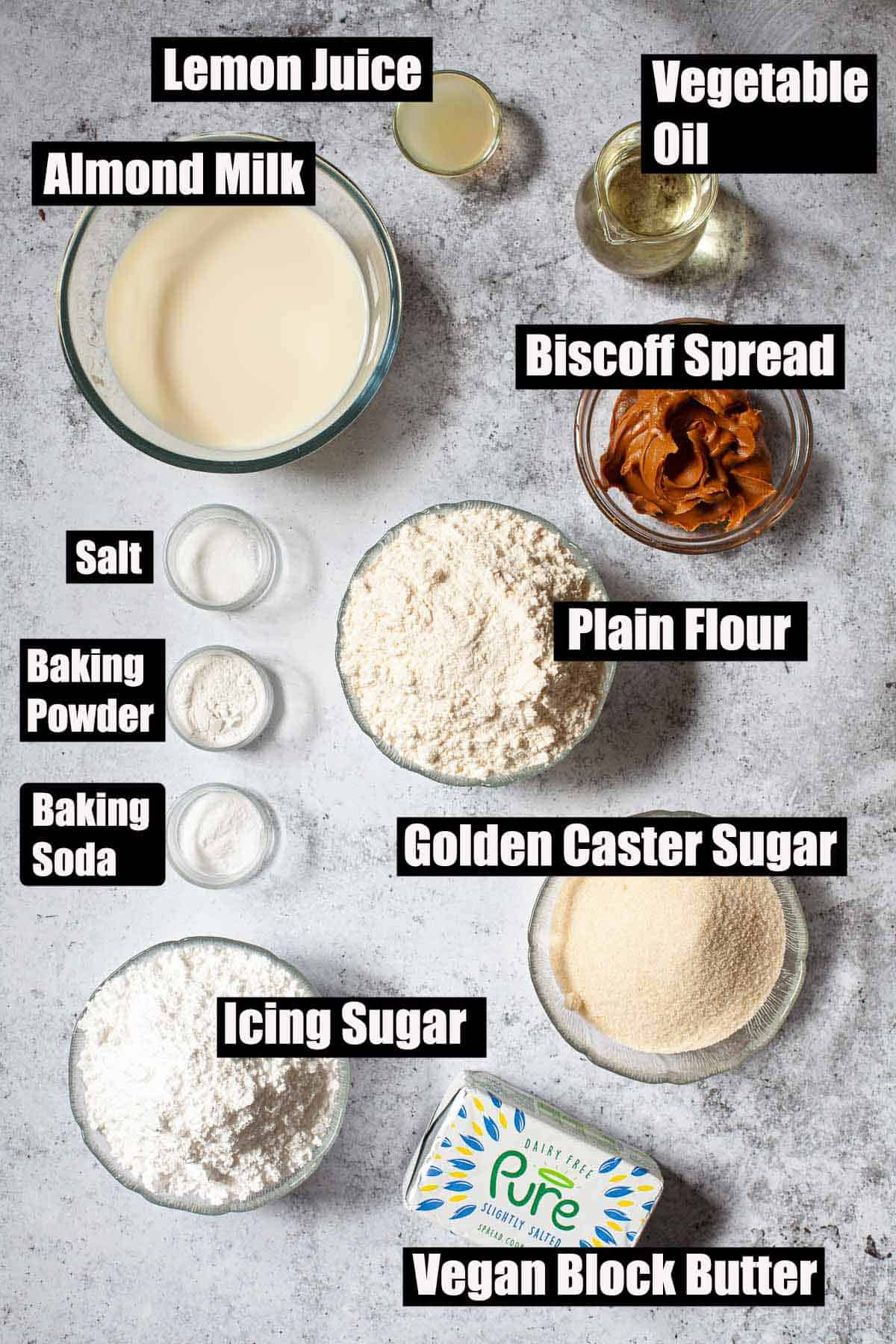
As this is a vegan Biscoff cake, there are no eggs and no dairy involved in making it. Instead, I’ve used vegan buttermilk, made by blending almond milk with lemon juice. This acidic liquid helps activate the raising agents in the cake. Other plant-based milk alternatives will also work, but they may not all curdle as well as almond milk does.
A tasteless/ neutral oil is used in place of butter when making the layers of Biscoff sponge cake. For this reason, a small amount of salt is needed to help draw out flavour in the cake. Don’t worry, this cake does not taste salty though.
Golden caster sugar has a subtle caramel flavour to it that works harmoniously with the Biscoff. If you don’t have it to hand then regular caster sugar will suffice.
When making the buttercream for this Biscoff drip cake, it is essential to use vegan butter that comes in a hard block as dairy butter does. There are plenty of options in stores now, but I get on well with Pure, Tomar and Naturli. Using a spreadable vegan butter variant will create a buttercream that is too loose.
Of course, the stars of the show in this vegan Biscoff cake recipe are the Biscoff cookies and spread. I recommend the smooth Biscoff spread for this recipe as it is easy to drip around the edge of the cake when melted.
Step by step instructions
Full instructions and measurements are given in the printable recipe card at the end of this post.
There are two stages to making this vegan Biscoff cake:
- Make the Biscoff sponge cake layers.
- Prepare the Biscoff buttercream & decorate the cake.
Make the vegan Biscoff cake layers
- Begin by mixing the almond milk and lemon juice to create a vegan buttermilk.
- Mix the dry ingredients together (flour, sugar, salt, baking powder, baking soda).
- Pour the wet ingredients (vegan buttermilk, oil & biscoff spread) into the bowl.
- Use electric beaters to blend everything together until just combined.
- Divide the batter between greased and lined baking tins and bake.
- Once cooked, let rest in the tins for 2 minutes, then turn out onto a wire rack to cool completely.
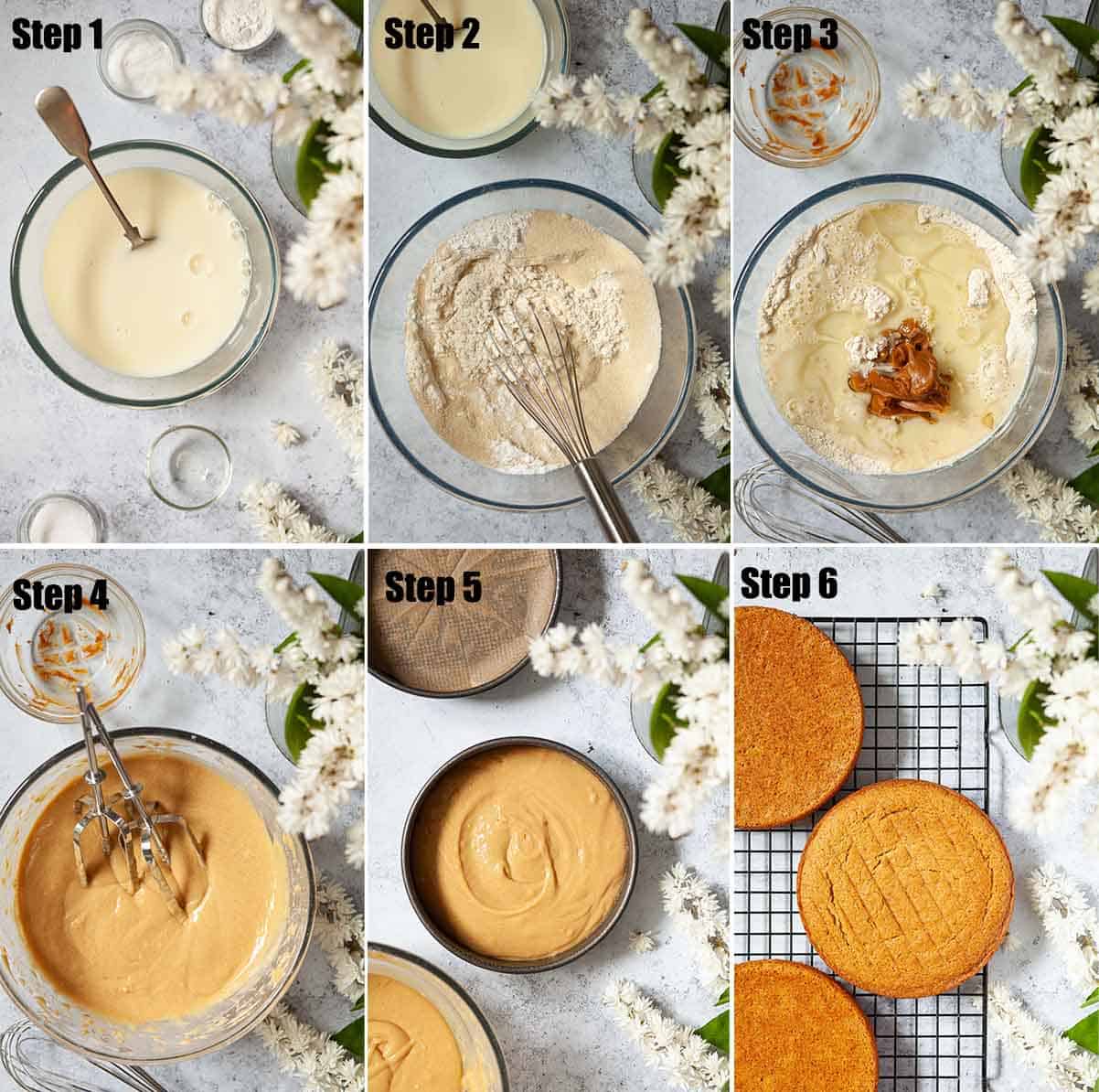
Make the vegan Biscoff buttercream and Biscoff drip
- Make the Biscoff buttercream: use electric beaters to cream the vegan block butter, Biscoff spread and icing sugar together.
- Spread a spoonful of Biscoff spread over the top of one layer of cake. Next add some buttercream.
- Crumble a cookie over the top. Place a second layer of sponge cake on top then repeat. All three sponge cakes should now be stacked on top of each other.
- Chill the cake stack for 30 minutes to help the crumbs firm up (it will be easier to ice.
- Use the remaining frosting to cover the outside and top of the cake then crush several cookies and use to decorate the side of the cake. Use a knife or your hands to push the crumbs up onto the cake.
- Heat the Biscoff spread in 10 second bursts on the defrost setting in a microwave until it is loose enough to pour. Place it in a squeezy bottle (or a piping bag) and drizzle the spread around the edge of the cake until it starts to drip down.
- Finally, crush another cookie and scatter around the edge of the cake top.
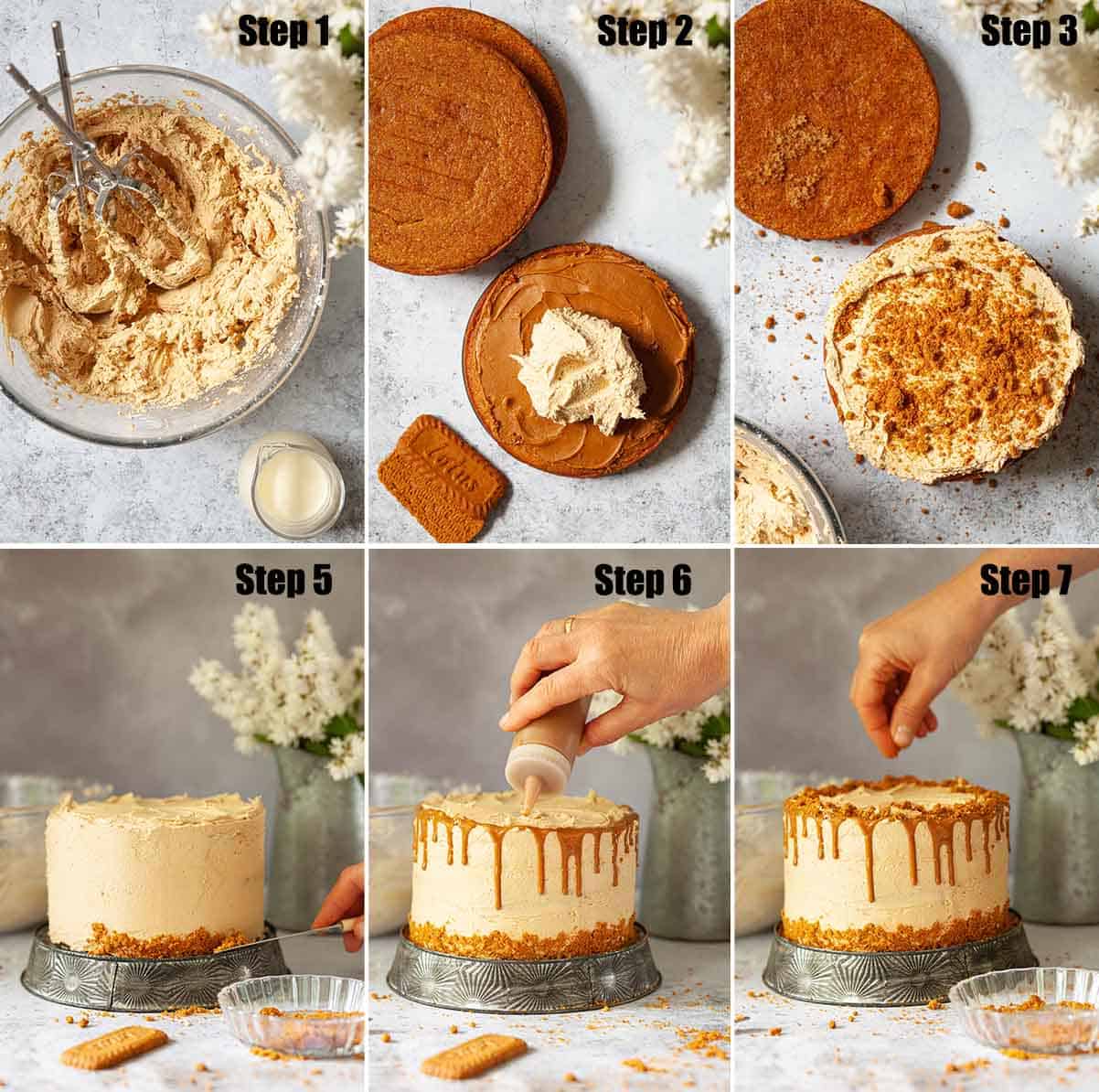
Expert tips
- Always use digital scales and the gram measuring system for this recipe as they are so much more accurate than the cup system. Cups are notoriously inaccurate because they can vary in size and one person’s method of filling a cup can be quite different to another person’s.
- Use the tin size specified (three x 6-inch round, tins). Trying to spread the batter into larger tins will affect the cooking time and make each layer much thinner than intended. It’s best to scale up the recipe for large tins (see notes at the end of the recipe card).
- Preheat the oven and prepare the baking tins before baking commences. This way the Biscoff cake can go into the oven as soon as it is mixed and the raising agents are activated.
- Always grease the tins and use a circle of baking parchment to line the bases, even if they are non-stick. Getting your cakes out will be so much easier if you do this.
- Each ingredient has its place and purpose in this recipe for vegan Biscoff cake. Leaving things out is really not advisable.
- Only make ingredient substitutions if you are an experienced baker and are confident the alternative will work. If in doubt send me a message and I’ll do my best to advise you.
- Let the cakes rest in their baking tins for 2 minutes once they are taken out of the oven. They will shrink slightly, pulling away from the edge of the tin. This helps get them out of the tins more easily.
- The layers in this Lotus Biscoff cake are a little more fragile than a traditional sponge cake – treat them gently when removing the baking paper and when decorating the cake.
- Wait until the sponge cakes are completely cold before sandwiching them together with the Biscoff buttercream (if the cakes are warm the frosting will melt).
- Take care not to overheat the Biscoff spread when attempting the drip around the edge of the cake. Heat until it just melts, it does not need to be hot (if it is too hot the buttercream will melt too).
Frequently asked questions
I’ve used almond milk in this vegan Biscoff cake because it reacts well with lemon juice to create a vegan buttermilk and it also has a mild taste. Oat milk or soy milk would work just as well.
Avoid using coconut milk as it has a slightly thicker texture and the cake may turn out denser than it should be. Coconut milk will also alter the flavour of the cake a little too.
Vegan buttercream is best made with vegan block butter alternatives rather than a softer spread. If you have made this Biscoff buttercream using a spreadable version this is why your buttercream is loose.
You can try adding a little more icing sugar to thicken it up, but it will sweeten the frosting significantly. You may be better to make an extra half-batch using hard vegan butter, then mix this in.
If it is too runny to use, try firming it up in the fridge for an hour or so before applying to the cake.
Yes, you can. Simply make and decorate this Biscoff drip cake as instructed then cut into slices, wrap and freeze (or wrap the entire cake and freeze it). Let defrost fully at room temperature before serving.
Alternatively, make and cool the layers of Biscoff sponge cakes then wrap and freeze for up to 2 months. Defrost and proceed with the rest of the recipe when the cake is needed.
Biscoff cookies and spread both contain gluten, so it is sadly not possible to easily adapt this Lotus Biscoff cake to be gluten-free. You would need to make gluten-free vegan versions of both the cookies and spread then also adapt the sponge cake recipe, making a suitable substitution with gluten-free flour.
If you do attempt this, I wish you success, but cannot vouch for how the recipe will turn out.
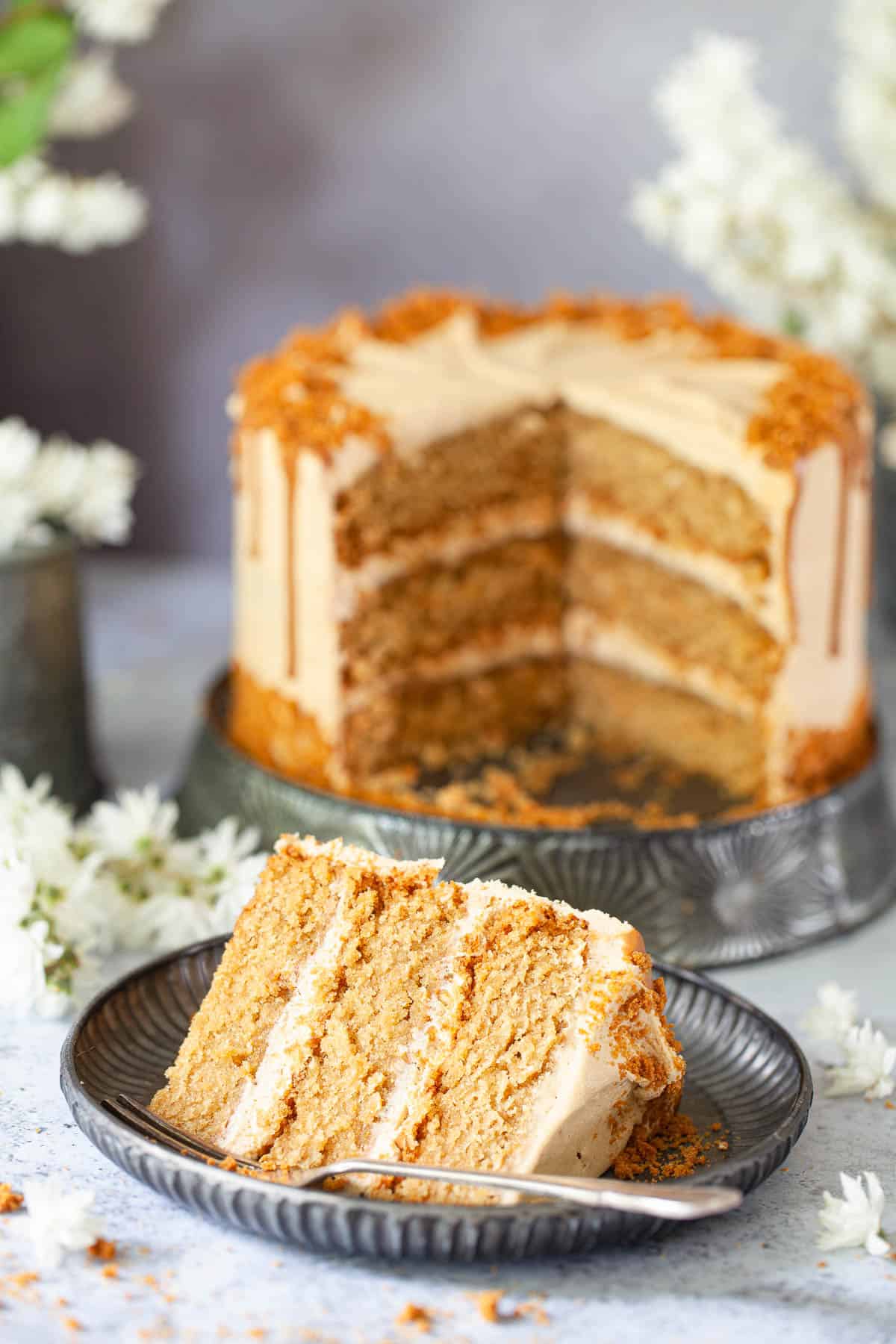
More Lotus Biscoff Recipes
Have you made this vegan Lotus Biscoff cake recipe? If you have please give it a rating or leave a comment – I love to hear how you get along with my creations.
Stay in touch: sign up to receive LittleSugarSnaps newsletters to hear when new recipes are published. Or follow me on social media:
📖 Recipe
Want to Save This Recipe?
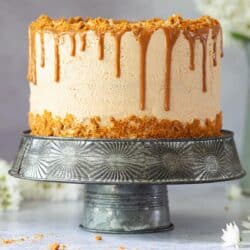
Vegan Lotus Biscoff Cake
Equipment
- 3 x 6-inch circular cake tins (see notes for different sizes)
Ingredients
For the Sponge Cakes
- 200 ml Almond Milk
- 1 tablespoon Lemon juice
- 250 g Plain flour all purpose
- 180 g Golden caster sugar
- 1½ teaspoons Baking powder
- ½ teaspoon Bicarbonate of soda baking soda
- ½ teaspoon Salt
- 80 ml Vegetable oil or other tasteless oil
- 125 g Biscoff spread Smooth or crunchy
For the Buttercream
- 225 g Icing sugar confectionary sugar
- 100 g Vegan block butter see notes
- 100 g Biscoff spread Smooth works best
Decoration
- 5 Biscoff cookies
- 5 tablespoons Biscoff spread Smooth (no not use crunchy)
Instructions
Make the Sponge Cakes
- Preheat the oven to 180C/ 350F/ GM 4
- Prepare 3 x 6-inch circular sandwich cake tins: grease well and place a circular disc of baking parchment into the base of each one (do this even if your tins are non-stick)
- Begin by mixing the almond milk and lemon juice to create a vegan buttermilk
- Mix the dry ingredients together (flour, sugar, salt, baking powder, baking soda) in a large bowl
- Pour the wet ingredients (vegan buttermilk, oil & biscoff spread) into the same bowl and use electric beaters to blend everything together until just combined
- Divide between the baking tins and bake for around 20 minutes
- Once cooked, let rest in the tins for 2 minutes, then turn out onto a wire rack to cool completely
Make the Buttercream
- Use electric beaters to cream the vegan block butter, Biscoff spread and icing sugar together
- Keep beating until smooth (add a little almond milk if it is too thick)
Assemble and Decorate
- Spread a spoonful of Biscoff spread over the top of one layer of cake
- Place a generous tablespoon of the buttercream over the top and spread out
- Crumble a cookie over the top
- Place a second layer of sponge cake on top then repeat the above 3 steps. All three sponge cakes should now be stacked on top of each other
- Chill the cake stack for 30 minutes to help the crumbs firm up (it will be easier to ice
- Use the remaining frosting to cover the outside and top of the cake. Make the sideasand top as smooth as possible (a benchscrapper will help)
- Crush several cookies and use to decorate the side of the cake. Use a knife or your hands to push the crumbs up onto the cake
- Heat the Biscoff spread in 10 second bursts on the defrost setting in a microwave until it is just loose enough to pour (do not let it get hot though as it will melt the buttercream when added to the cake)
- Place it in a squeezy bottle (or a piping bag) and drizzle the spread around the edge of the cake until it starts to drip down
- Finally, crush another cookie and scatter around the edge of the cake top
Notes
- Always use digital scales for this recipe as they are so much more accurate than the cup system. Cups are notoriously inaccurate because they can vary in size and one person’s method of filling a cup can be quite different to another person’s
- Use the tin size specified (three x 6-inch round, tins). Trying to spread the batter into a larger tins will affect the cooking time and make each layer much thinner than intended. It’s best to scale up the recipe for large tins (see notes at the end of the recipe card)
- Preheat the oven and prepare the baking tins before baking commences. This way the cake can go into the oven as soon as it is mixed and the raising agents are activated
- Always grease the tins and use a circle of baking parchment to line the bases, even if they are non-stick. Getting your cakes out will be so much easier if you do this
- Each ingredient has its place and purpose in this vegan Biscoff cake recipe. Leaving things out is really not advisable
- Only make ingredient substitutions if you are an experienced baker and are confident the alternative will work. If in doubt send me a message, I may be able to advise
- I’ve used almond milk because it reacts well with lemon juice to create a vegan buttermilk and it also has a mild taste. Oat milk or soy milk would work just as well
- Avoid using coconut milk as it has a slightly thicker texture and the cake may turn out denser than it should be. Coconut milk will also alter the flavour of the cake a little too.
- Let the cakes rest in their baking tins for 2 minutes once they are taken out of the oven. They will shrink slightly, pulling away from the edge of the tin. This helps get them out of the tins more easily
- This cake is a little more fragile than a traditional sponge cake – treat it gently when removing the baking paper and when decorating it
- Wait until the sponge cakes are completely cold before sandwiching with the buttercream (if the cakes are warm the frosting will melt)
- Vegan buttercream is best made with vegan block butter alternative rather than a softer spread. Using softer spreads creates a very loose buttercream
- Take care not to overheat the Biscoff spread when attempting the drip around the edge of the cake. Heat until it just melts, it does not need to be hot

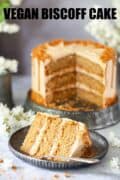
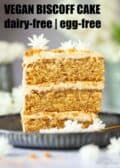
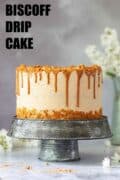
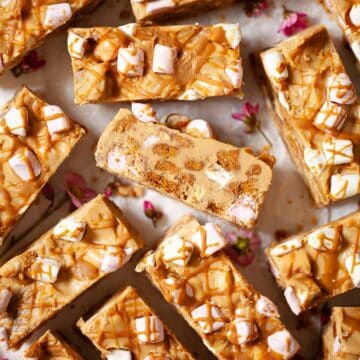

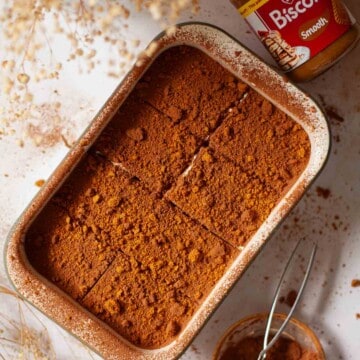
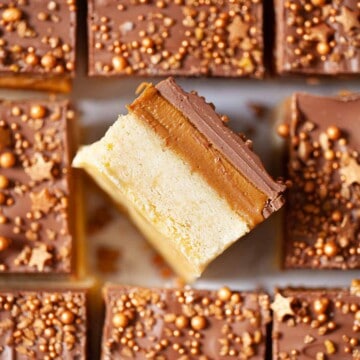
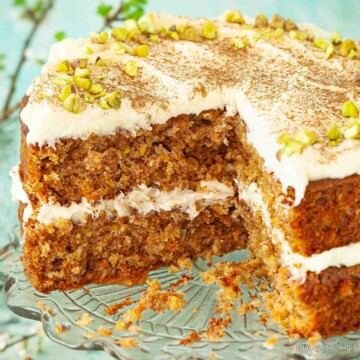
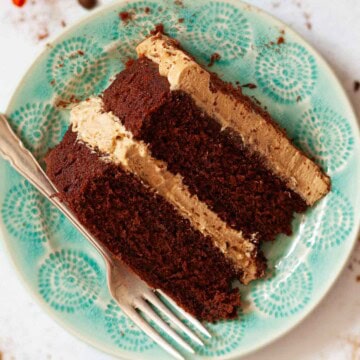
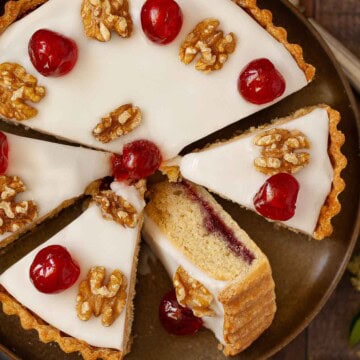

Claire
Can I replace the biscoff spread with caramel sauce?
Jane Coupland
Hi Claire, I haven’t tried this but I don’t see why not. I’d make sure the sauce is nice and thick (as close to the consistency of the Biscoff spread as possible) so that the cake and buttercream retains it’s structure. Any caramel that is too loose might cause the dessert to be on the sloppy side. let me know how you get along 🙂
Irene
I know you say we should use the 6 inch pans but it’s hard for me to find it in the store today, and it’s on my to do list so is there any way I can make this a 2 layer 8 inch cake instead? If not, then I’ll have to wait until my amazon order comes in. Thanks
Jane Saunders
Hi Irene, you can indeed make it a 2 layered cake in 8-inch tins – there’s a little write-up about this in the notes section of the recipe card actually as I appreciate 6-inch pans are less common than 8-inch pans. You may need to bake for a few more minutes to ensure the middle of the cakes are cooked. Hope you enjoy it.
Tessa
Makes a wonderful Birthday Cake. Very yummy indeed and enjoyed by everyone.
Jane Saunders
Thankyou Tessa – many happy returns!